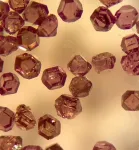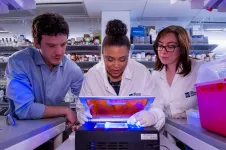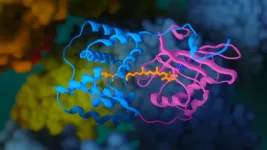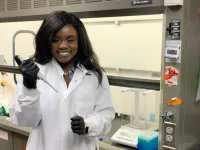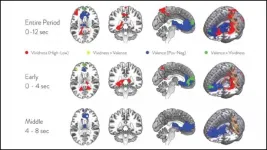(Press-News.org) When doctors or scientists want to peer into living tissue, there's always a trade-off between how deep they can probe and how clear a picture they can get.
With light microscopes, researchers can see submicron-resolution structures inside cells or tissue, but only as deep as the millimeter or so that light can penetrate without scattering. Magnetic resonance imaging (MRI) uses radio frequencies that can reach everywhere in the body, but the technique provides low resolution -- about a millimeter, or 1,000 times worse than light.
A University of California, Berkeley, researcher has now shown that microscopic diamond tracers can provide information via MRI and optical fluorescence simultaneously, potentially allowing scientists to get high-quality images up to a centimeter below the surface of tissue, 10 times deeper than light alone.
By using two modes of observation, the technique also could allow faster imaging.
The technique would be useful primarily for studying cells and tissue outside the body, probing blood or other fluids for chemical markers of disease, or for physiological studies in animals.
"This is perhaps the first demonstration that the same object can be imaged in optics and hyperpolarized MRI simultaneously," said Ashok Ajoy, UC Berkeley assistant professor of chemistry. "There is a lot of information you can get in combination, because the two modes are better than the sum of their parts. This opens up many possibilities, where you can accelerate the imaging of these diamond tracers in a medium by several orders of magnitude."
The technique, which Ajoy and his colleagues report this week in the journal Proceedings of the National Academy of Sciences, utilizes a relatively new type of biological tracer: microdiamonds that have had some of their carbon atoms kicked out and replaced by nitrogen, leaving behind empty spots in the crystal -- nitrogen vacancies -- that fluoresce when hit by laser light.
Ajoy exploits an isotope of carbon -- carbon-13 (C-13) - that occurs naturally in the diamond particles at about 1% concentration, but also could be enriched further by replacing many of the dominant carbon atoms, carbon-12. Carbon-13 nuclei are more readily aligned, or polarized, by nearby spin-polarized vacancy centers, which become polarized at the same time they fluoresce after being illuminated with a laser. The polarized C-13 nuclei yield a stronger signal for nuclear magnetic resonance (NMR) -- the technique at the heart of MRI.
As a result, these hyperpolarized diamonds can be detected both optically -- because of the fluorescent nitrogen vacancy centers -- and at radio frequencies, because of the spin-polarized carbon-13. This allows simultaneous imaging by two of the best techniques available, with particular benefit when looking deep inside tissues that scatter visible light.
"Optical imaging suffers greatly when you go in deep tissue. Even beyond 1 millimeter, you get a lot of optical scattering. This is a major problem," Ajoy said. "The advantage here is that the imaging can be done in radio frequencies and optical light using the same diamond tracer. The same version of MRI that you use for imaging inside people can be used for imaging these diamond particles, even when the optical fluorescence signature is completely scattered out."
Detecting nuclear spin
Ajoy focuses on improving NMR -- a very precise way of identifying molecules -- and its medical imaging counterpart, MRI, in hopes of lowering the cost and reducing the size of the machines. One limitation of NMR and MRI is that large, powerful and costly magnets are needed to align or polarize the nuclear spins of molecules inside samples or the body so that they can be detected by pulses of radio waves. But humans can't withstand the very high magnetic fields needed to get lots of spins polarized at once, which would provide better images.
One way to overcome this is to tweak the nuclear spins of the atoms you want to detect so that more of them are aligned in the same direction, instead of randomly. With more spins aligned, called hyperpolarization, the signal detected by radio is stronger, and less powerful magnets can be used.
In his latest experiments, Ajoy employed a magnetic field equivalent to that of a cheap refrigerator magnet and an inexpensive green laser to hyperpolarize the carbon-13 atoms in the crystal lattice of the microdiamonds.
"It turns out that if you shine light on these particles, you can align their spins to a very, very high degree -- about three to four orders of magnitude higher than the alignment of spins in an MRI machine," Ajoy said. "Compared to conventional hospital MRIs, which use a magnetic field of 1.5 teslas, the carbons are polarized effectively like they were in a 1,000-tesla magnetic field."
When the diamonds are targeted to specific sites in cells or tissue -- by antibodies, for example, which are often used with fluorescent tracers -- they can be detected both by NMR imaging of the hyperpolarized C-13 and the fluorescence of the nitrogen vacancy centers in the diamond. The nitrogen vacancy-center diamonds are already becoming more widely used as tracers for their fluorescence alone.
"We show one important cool feature of these diamond particles, the fact that they spin polarize -- therefore they can glow very bright in an MRI machine -- but they also fluoresce optically," he said. "The same thing that endows them with the spin polarization also allows them to fluoresce optically."
The diamond tracers also are inexpensive and relatively easy to work with, Ajoy said. Together, these new developments could, in the future, allow for an inexpensive NMR imaging machine on every chemist's benchtop. Today, only large hospitals can afford the million-dollar price tag for MRIs. He currently is working on other techniques to improve NMR and MRI, including using hyperpolarized diamond particles to hyperpolarize other molecules.
INFORMATION:
The experiments were led by former graduate student Xudong Lv using a home-built hyperpolarizer device constructed by staff scientist Emanuel Druga. Other co-authors are F. Wang, A. Aguilar, T. McKnelly, R. Nazaryan and L. Wu of UC Berkeley; J. H. Walton of UC Davis; O. Shenderova of Adamas Nanotechnologies Inc., in North Carolina; D. B. Vigneron of UCSF; Carlos Meriles of the City University of New York; and professor of chemical and biomolecular engineering Jeffrey Reimer and chemistry professor Alexander Pines, both of UC Berkeley.
Ajoy's work was supported by the Office of Naval Research (N00014-20-1-2806).
PHILADELPHIA and MELBOURNE, Australia -- (May. 17, 2021) -- A team of scientists from The Wistar Institute in Philadelphia and the Peter MacCallum Cancer Center in Melbourne, Australia, discovered a new checkpoint mechanism that fine-tunes gene transcription. As reported in a study published in Cell, a component of the Integrator protein complex tethers the protein phosphatase 2A (PP2A) to the site of transcription allowing it to stop the activity of the RNA polymerase II enzyme (RNAPII). Disruption of this mechanism leads to unrestricted gene transcription and is implicated in cancer.
The study points to new viable opportunities for therapeutic ...
Exposure to light is compulsory for photosynthetic organisms for the conversion of inorganic compounds into organic ones. However, if there is too much solar energy, the photosystems and other cell components could be damaged. Thanks to special protective proteins, the overexcitation is converted into heat - in the process called non-photochemical quenching. The object of the published study, OCP, was one of such defenders. It was first isolated in 1981 from representatives of the ancient group of photosynthetic bacteria, ?yanobacteria. OCP comprises two domains forming a cavity, in which a carotenoid pigment is embedded.
"When light is absorbed by the carotenoid molecule, OCP can change from an inactive orange to an active red form. ...
For much of the nation's food supply, removing unsafe products off of store shelves can take up to 10 months, according to news reports -- even when people are getting sick.
The growing complexity and scope of modern supply chains result in painfully slow product recalls, even when consumer well-being is at stake. For example, in 2009, salmonella-tainted peanuts killed nine people and sickened more than 700 in 46 states, and the resulting nationwide recall cost peanut farmers, their wholesale customers and retailers more than $1 billion in lost production ...
Viruses attack the body by sending their genetic code -- DNA and RNA -- into cells and multiplying. A promising class of therapeutics that uses synthetic nucleic acids to target and shut down specific, harmful genes and prevent viruses from spreading is gaining steam.
However, only a handful of siRNA, or other RNA interference-based therapeutics have been approved. One of the main problems is getting the siRNA into the body and guiding it to the target.
Chemical engineering researchers in the Cockrell School of Engineering aim to solve that problem, while improving the targeting effectiveness of siRNA. In a new paper in the Journal of Controlled Release, the researchers created several different types of nanoparticles and analyzed them for the ability to deliver and protect siRNA from ...
May 17, 2021 - Amid the rising toll of opioid overdoses and deaths in the U.S., several states are considering laws enabling civil commitment for involuntary treatment of patients with substance use disorders (SUDs). Most addiction medicine physicians support civil commitment for SUD treatment - but others strongly oppose this approach, reports a survey study in Journal of Addiction Medicine, the official journal of the American Society of Addiction Medicine (ASAM). The journal is published in the Lippincott portfolio by Wolters Kluwer.
"Civil commitment has emerged as a sometimes compelling yet controversial policy option," according to the new study, led by Abhishek Jain, MD. At the time of ...
Some 16 million Americans are believed to have alcohol use disorder, and an estimated 93,000 people in the U.S. die from alcohol-related causes each year. Both of those numbers are expected to grow as a result of heavier drinking during the COVID-19 pandemic.
Yet, in a new study involving data from more than 200,000 people with and without alcohol problems, researchers at Washington University School of Medicine in St. Louis found that although the vast majority of those with alcohol use disorder see their doctors regularly for a range of issues, fewer than one in 10 ever get treatment for drinking.
The findings are published in the June issue of the journal Alcoholism: Clinical & Experimental Research.
Analyzing data gathered from 2015 through 2019 via the National ...
In a world that's changing fast, the Long Term Ecological Research (LTER) Network can seem almost an anachronism. Yet the patience and persistence that have generated 40 years of careful, reliable science about the Earth's changing ecosystems may prove to be just what's needed in this rapidly shifting world. We can't wait for a crystal ball -- and we don't have to. By harnessing decades of rich data, scientists are beginning to forecast future conditions and plan ways to manage, mitigate, or adapt to likely changes in ecosystems that will impact human economies, health and wellbeing.
The National Science Foundation established the LTER Network more than 40 years ago to provide an alternative to funding models that favored constant innovation over continuity. The model has proven to be extraordinarily ...
An international study has found that four out of five women in prison in Scotland have a history of head injury, mostly sustained through domestic violence. Published recently in The Lancet, researchers, including SFU psychology graduate student Hira Aslam, say the study has important implications for the female prison population more broadly and could help to inform mental health and criminal justice policy development.
"The findings are incredibly sobering," says Aslam. "While we anticipated that the incidence of head injuries among women who are involved in the criminal justice system would be high, these estimates exceeded our expectations."
Researchers also found that violent criminal behaviour was three times more likely among women who had a history of significant head injury, ...
ATS 2021, New York, NY - Air quality standards recommended by the American Thoracic Society (ATS) have the potential to prevent more illness and death than standards adopted by the U.S. Environmental Protection Agency (EPA), according to research presented at the ATS 2021 International Conference.
Laura Gladson, MS, a research scholar with the Air Quality Program at the Marron Institute of Urban Management, New York University (NYU) and colleagues from NYU and the ATS assessed differences between the potential public health protections provided by EPA air quality standards and the more stringent standards proposed by the ATS. Comparing real-world ...
Two components of imagination -- constructing and evaluating imagined scenarios -- rely on separate subnetworks in the default mode network, according to research recently published in JNeurosci.
Even when you aren't doing anything, your brain is hard at work. The default mode network (DMN) activates during the brain's resting state and has been linked to daydreaming, planning, and imagining the future. In previous studies, scientists noticed the DMN could be divided into two subnetworks, ventral and dorsal, but their different roles were debated.
Lee et al. used fMRI to measure participants' brain activity while they imagined scenarios listed on prompts, like "Imagine you win the lottery." The scenarios ...
